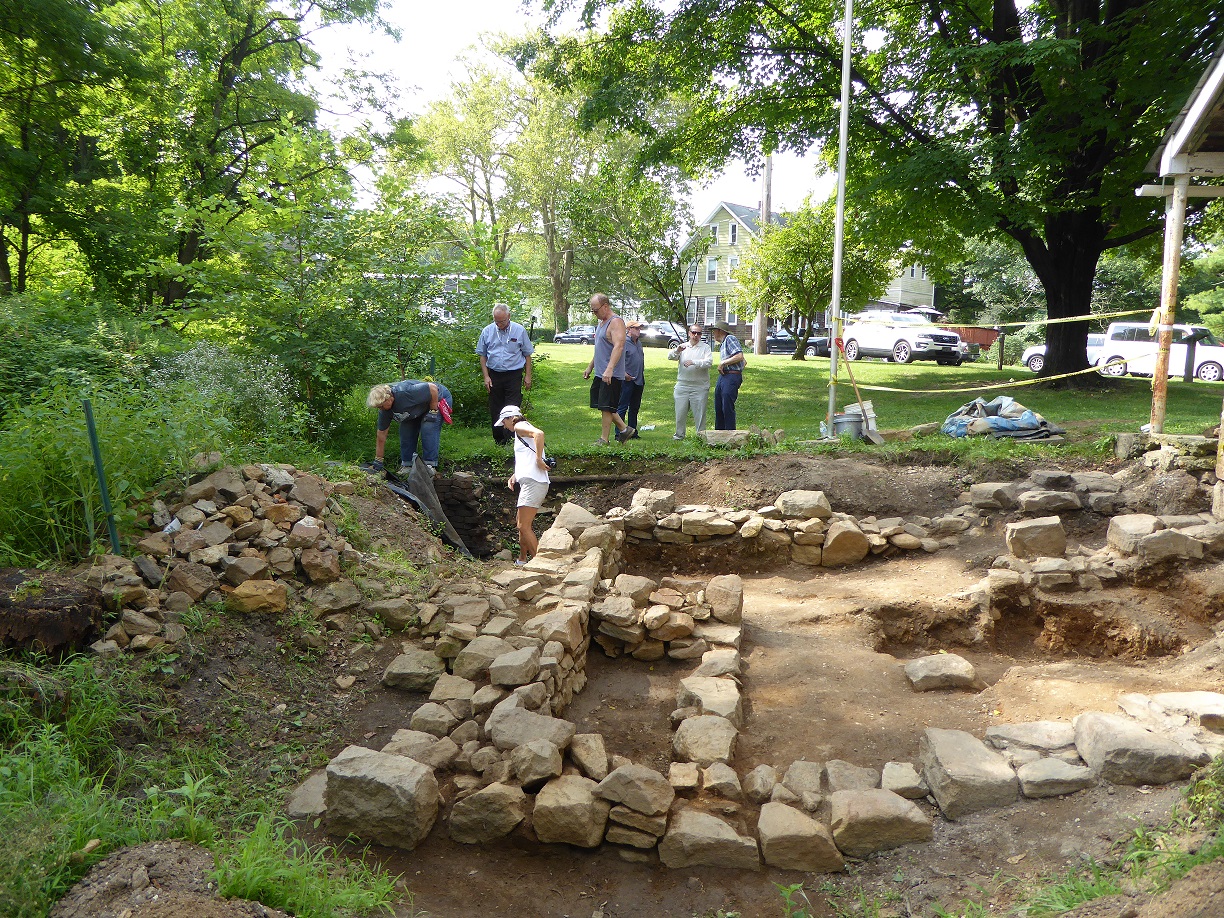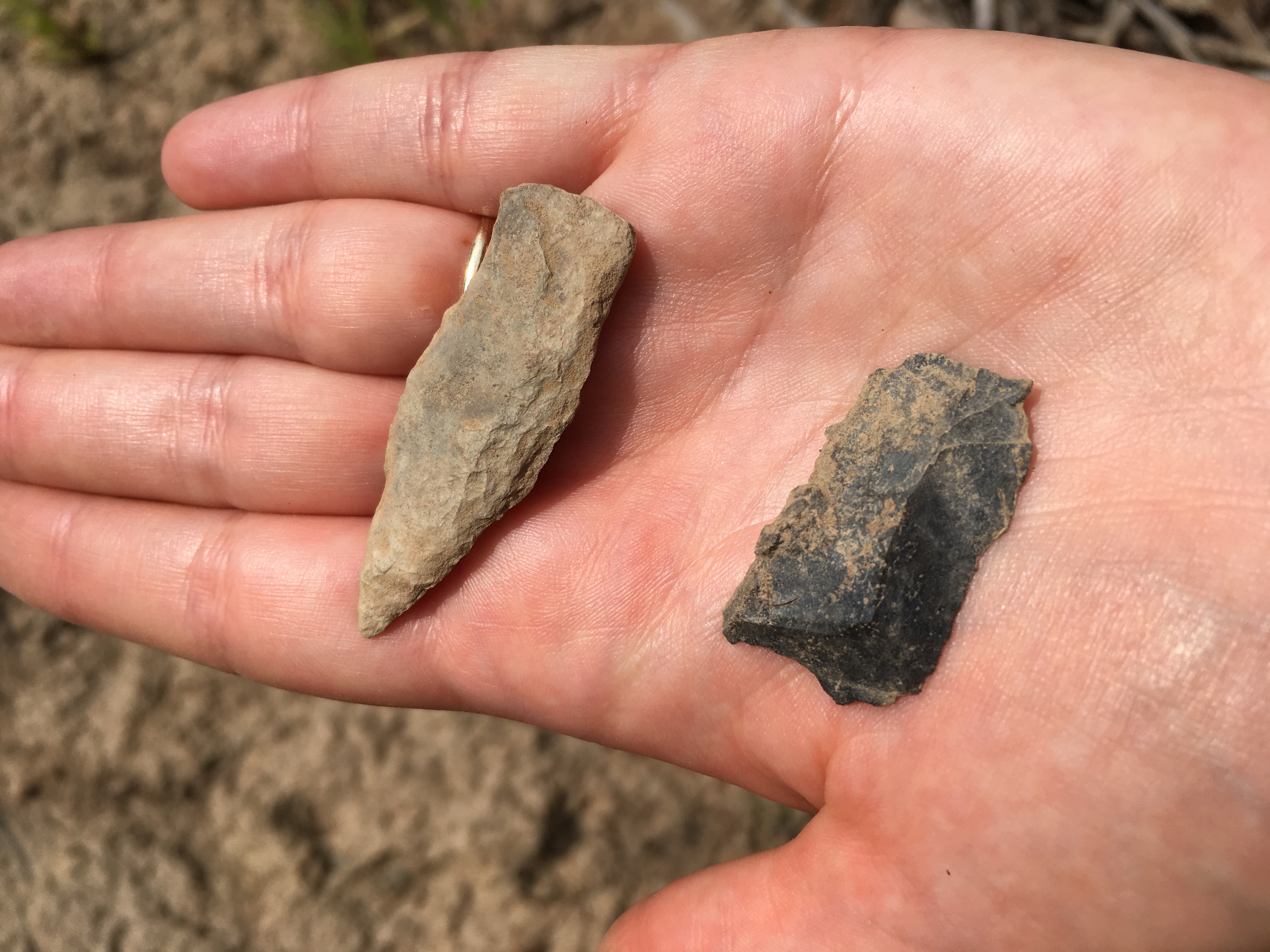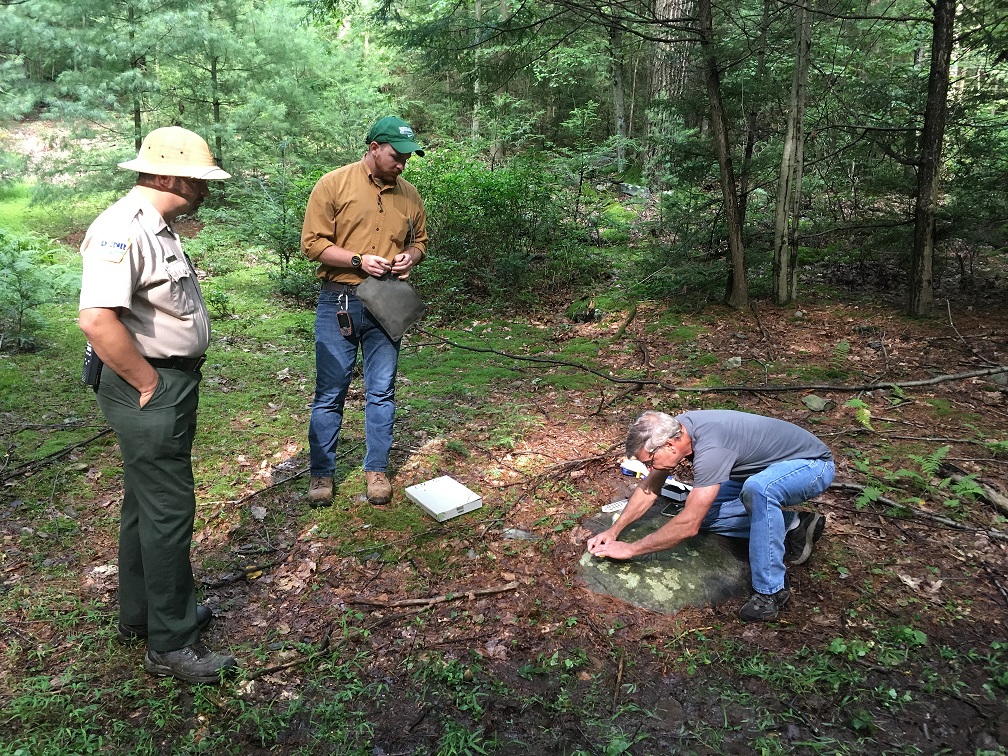Pennsylvania Archaeological Site Survey (PASS)
The Pennsylvania Archaeological Site Survey (PASS) is our statewide inventory of over 25,000 recorded archaeological sites, representing 16,000 years of Pennsylvania's history. Archaeological sites have been recorded in Pennsylvania since the 1940s based on information collected by avocational archaeologists, university researchers, museums, and consulting archaeologists. The inventory is maintained by the PA SHPO and made available for the benefit of all Pennsylvanians.
What is an archaeological site?
An archaeological site is a place that contains physical evidence of past human occupation or activity. That evidence can take the form of artifacts--such as projectile points, pottery, and metal items—or features—such as foundations, ruins, hearths, pits, or burials.

SHPO archaeologists on a 2019 site visit to the 1803 House (36LH0363) in Emmaus with members of the Friends of the 1803 House, the borough council, and faculty from Lehigh University.
In Pennsylvania, we have developed
site identification criteria to guide site recorders and to standardize our site inventory. Sites recorded in Pennsylvania include a wide range of activities and time periods, including Native American camps, processing sites, and quarries, and historic-period homes, industries, and battlefields.
What is Site Recording?
Recording sites in the PASS files preserves basic information about archaeological sites – the when, where, and what – in PA-SHARE. Information collected in the files includes:
- Site locations and boundaries
- Information about field investigations and methodology
- Findings such as artifacts, features, analysis, and interpretations
- Site chronology
- Environmental data
- Who investigated the site, and when
- Supplemental documentation such as photos, historic maps, drawings, profiles, catalogs, and more!
Pennsylvania uses the Smithsonian trinomial system to record site locations and to catalog artifact collections. This helps ensure that we retain the context and association that is so important to our understanding of the past.

Lithic artifacts located by SHPO staff at a multi-component site on Three Mile Island (36DA0100) during a site visit in 2019.
Anatomy of a Site Number
The Smithsonian's trinomial site designations are comprised of three parts: a state identification number, a two-letter code identifying the county in which the site is located, and a sequential site number within that county.
- State identification numbers were established by alphabetical order in the 1940s. At that time, Pennsylvania was the 36th state by alphabetical order; therefore, all archaeological site designations in Pennsylvania begin with the number 36.
- The county code, a two-letter designation, is representative of the specific county in which a site is located. Each county has a unique county code.
- The final part of the trinomial site designation is the site number which corresponds to a specific site within a county. These numbers are assigned in sequential order once a PASS form is received, and it has been determined that the resource is an archaeological site based upon site identification criteria, and that the site has not been previously recorded.
For example, site number 36AD0001 represents the first site (0001) recorded within Adams County (AD) in Pennsylvania (36).
Why Record Sites
There are many good reasons to record an archaeological site:
- Archaeological excavation is inherently destructive! Site recording is one of many ways to ensure that the
information is not lost.
-
It helps all of us learn from the past and adds to our body of archaeological knowledge.
-
Recording is an important step in the consideration and potential protection of sites under state and federal cultural resources laws.
-
The PASS files are a mechanism for sharing information with other archaeologists and interested citizens.
-
It permanently links site locations with collections held by individual collectors, museums, and universities.
-
It's the right thing to do!
How to Record Sites
New sites can be recorded electronically using PA-SHARE. Anyone with a Basic, Pro or Business account can submit sites. For more information about submitting a site, please see the Adding an Archaeological Resource to PA-SHARE tutorial.
2019 PASS intern Doug Riethmuller (center) on a field view in Michaux State Forest with staff from Caledonia State Park and the Zimmerman Center for Heritage.
Guidance for Site Recording
PA SHPO is currently updating its guidance for submitting archaeological sites using PA-SHARE. When available, the updated guidance will be available here.
How can I be involved?
We welcome site information from everyone, including museums, historical societies, students, and collectors! Recording what you have found—and where you found it—is an important step in learning about the past and protecting these important places. Please contact us for more information about recording your finds.
What does the PASS program offer?
SHPO archaeologists offer the following services to assist individuals, organizations, and communities who wish to record archaeological sites:
- Technical assistance documenting sites and planning research surveys
-
Educational lectures about Pennsylvania archaeology
-
Access to full-detail site information for archaeological professionals and upper-level college research projects
-
Training on site documentation methods
-
Site visits
-
Collection documentation.
Frequently Asked Questions
Q. How do I know if what I found is an archaeological site?
A. Read our
Site Identification Criteria (PDF).
Q. If I record this site, will the State stop me from developing my land?
A. No. The role of the State Historic Preservation office is to advise agencies on projects that involve state or federal money and permits. It cannot stop private landowners from developing on their own land.
Q. Once I record this site, won't everyone be able to find it and dig it up?
A. No. Site locations are protected information and are not available to the general public.
Q. I have all these artifacts from my site, what do I do with them now?
A. Read the
State Museum of Pennsylvania's Curation Guidelines (PDF) to learn the proper way to care for artifacts. In addition, the Section of Archaeology at the State Museum accepts collections from provenienced sites and locations. Donating your collections ensures the long-term preservation of their research potential.
Q. Can I collect artifacts from any site I want?
A. Not necessarily. Remember, if sites are on private land, you need the landowner's permission before you can visit that site. Also, it is a criminal offense to collect artifacts from State or Federal land.
Q. I have a site that I want to dig. How do I conduct an archaeological dig?
A. First, if the site is not on your land, make sure you have permission. Next, we suggest contacting a professional or an experienced avocational archaeologist who can show you the proper methods. A good place to look is to contact local universities and colleges or your local
Society for Pennsylvania Archaeology chapter.
Remember that one of the most important things about digging at an archaeological site is collecting the information as you dig. Archaeology is a destructive science. Once the site is gone, if proper notes were not taken, the information will be lost forever. It is important to keep detailed records of what was found and where you found it.
Q. Where can I view information about sites in Pennsylvania?
A. Information about Pennsylvania's archaeological sites is available in PA-SHARE. Given the sensitive nature of information associated with archaeological sites, public users can only view very limited information pertaining to sites in PA-SHARE. More detailed information, including site locations, can be viewed by requesting archaeology privileges from PA SHPO.
Archaeological privileges are granted to individuals who meet the Secretary of the Interior's Professional Qualifications Standards wtih a speciality in prehistoric, historic and/or underwater archaeology or geomorphology. For more information and to request these privileges, please visit the Request Archaeology Privileges page.
Additional Resources
For more information about the PASS program, contact Taylor Napoleon at tnapoleon@pa.gov.
For more information about archaeology in Pennsylvania: